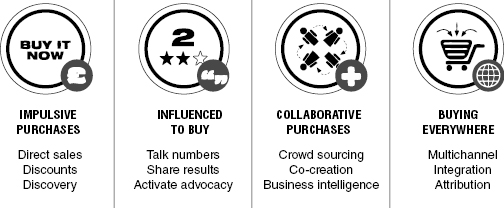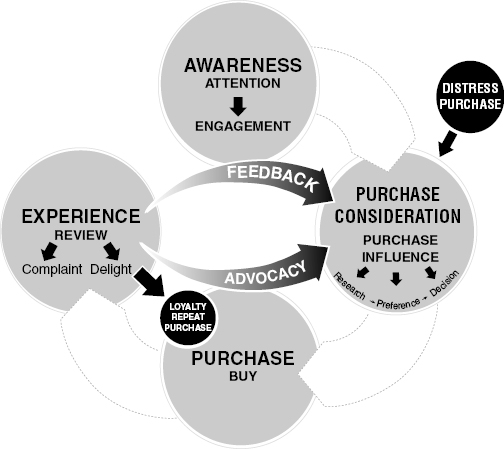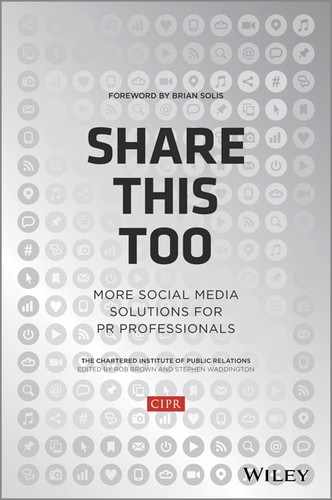Chapter 27
Social Commerce: Show Me the Money
As the potential value of social media reaches the boardroom, the big question looms large: can social media drive sales? This chapter explores ways in which to monetize conversations and connections, detailing best practice and latest innovations in social commerce.
There are many ways in which to evaluate results from social media, but none as sharp or as pleasing to the board as increasing sales. It seems obvious, then, that at least some part of your social media programme directly drives purchases. This is social commerce.
Back in 2010, Facebook founder, Mark Zuckerberg, saw the opportunity. He said: “If I had to guess, social commerce is next to blow up.” Since then all the tech providers, app developers, platforms and social networks are investing in turning chatter into money.
The term social commerce isn't new. In fact, it was used by Yahoo! in November 2005. The phrase social commerce is now well established and can be briefly described as transactions resulting from social media.
Brands, businesses and entrepreneurs that are experimenting in social selling are learning quickly how social media is both a driver and contributor to sales.
There are doubters though. A Forrester Research analyst was quoted as saying that trading on Facebook is “like trying to sell stuff to people while they're hanging out with their friends at the bar”. On the face of it, that seems like a sensible conclusion. After all, the thinking goes, we spend time on our networks to be with friends – not really to shop.
IBM's 2012 Black Friday240 report reveals how poorly social estates performed in delivering last click to sale. The analysis suggests that Facebook, Twitter, LinkedIn, and YouTube generated 0.34% of all online sales on Black Friday, down 35% from 2011.
Yet there are documented successes, indicating significant promise and growth potential. Evidence that tells us that Black Friday aside, we should not dismiss the sales opportunity so fast:
- When a user posts on their news feed that they have bought a ticket, Ticketmaster gains an additional $5.30 from socially connected friends wanting to attend the same event.
- Fab.com reports a 15% conversion rate241 from traffic generated through discovery in news feeds and shares in social media.
- Play.com attributes £2 million of sales to Facebook, with engaged fans spending 24% more than those that didn't come from the social network.
There is confidence in the future success of social commerce. Booz & Co research242 estimates that social commerce sales will total $30 billion worldwide by 2015. Analysis of customers' purchase journeys reveals the value social has in contributing to the sale – 71% of consumers243 are more likely to purchase based on social media referrals. People connect, discuss, review and rate products and services. It appears that when you look beyond last click data, social media is increasingly essential to purchase decisions.
Technology continues to evolve, making selling through social easier, but technology is not the whole story. In truth, social selling is more complex. It is much more akin to real-world shopping where understanding behaviours is the key to unlocking sales. Because when you understand your audience, you can design your social activity to sell and influence purchase.
There are four social shopping behaviours that inform your social commerce approach:
©immediatefuture

Impulsive purchases: harnessing the spontaneous buyer
Social media is not the natural home of shopping. When people want to buy, they don't go to their social networks; they go to search, retail stores, review sites and to the shops with specific intentions.
Many of the original Facebook storefronts launched by Gap, Old Navy and Gamestop are now closed. ASOS too launched a Facebook store in January 2011 that closed a year or so later. Most withdrew due to poor sales. People don't quite trust transacting within Facebook just yet; nor do they tend to return to pages once they've “liked” them. Social stores that replicated the whole catalogue often performed much slower. Not a great experience.
Still, this doesn't prove that social networks don't have value as sales channels. It is more likely that businesses haven't yet identified the right way to approach consumers on social platforms.
What is apparent is that people will buy on social through impulse. A report from Ryan Partnership244 suggests 22% of those who follow retailers have been influenced to make an unplanned purchase, and 15% report having spent more as a consequence. Interestingly, the least influential in driving unplanned purchases were search engines (5%).
Get the timing, proposition and mechanics right and businesses can tap into impulse purchases. There are three ways to motivate a spontaneous purchase:
1. Direct links unlock sales
Facebook rather leads the charge on driving sales to sites outside of the network. By tapping into news streams it is proven to deliver significant returns. According to Burberry, last year 29.1% of site traffic was from Facebook.
But Facebook has competition. The jewellery and accessories e-tailer Boticca claims that integrated “Pinterest buttons” on its website assist around 10% of sales and bring 86% of visits from new customers. Twitter, too, is not to be outdone. For Zappos an order shared on Twitter generates $33.66 in sales: 45 times that of a Pin.245
Facebook realizes the value of the impulse purchase and is looking at ways to harness the opportunity. It is currently allowing US consumers to purchase gifts for friends – tapping into events such as birthdays. Already proving to be successful, it is likely to roll out in the UK in 2013.
Timeliness and frequency are crucial for success. By focusing on the posts, tweets and Pins that deliver the traffic and conversions, you can optimize this process.
2. Discounts and flash deals to motivate and drive immediacy
It seems obvious that discounts in social media are likely to increase sales. It offers instant gratification for the buyer. Almost a third of Europeans connect with retailers for deals, coupons, promotions and flash sales.246
On Google+, brands are increasingly delivering results with discounts and flash sales. Fashion brands lead the way with Top Man, New Look, Very, Boden, Uniqlo and H&M all gathering momentum on the platform and driving traffic through discounts and offers. In fact, H&M claims247 to have increased click through rates by 22% as a result of activity on Google+.
The American Express Sync programme allows cardholders to match their cards to Twitter, Foursquare or Facebook accounts, select from a list of offers and digitally add them to their credit cards – a clever mechanism that allows automatic redemption for simplicity and rewards sharing in social media.
Promotions often deliver an immediate ROI too. They are simple to deploy using apps, coupons, hashtags and pop-up stores for flash sales. However, they still need to be used judiciously or they can undermine your brand, impair relationship building and erode your profit margin.
3. Discovery to inspire spontaneous purchase
Amazon is deft at using links to inspire impulse purchases. Its recommendation engine is the cornerstone of its success. It now has “Pages” for brands to use in aiding the discovery of new products, allowing businesses to create customized destinations and posts to promote products and mirror the success of Facebook Pages.
Facebook is experimenting with “Collections”, a Pinterest-style feature that allows users to create wish lists through “Want” or “Collect” buttons. And you can't blame them for copying the well-known pinboard when a report suggests that 70% of Pinterest users are inspired to purchase (compared to just 21% on Facebook).248
YouTube, too, is getting in on the act. Homebase has a store on the video channel that allows people to explore images and click on products that take you through to relevant pages on the ecommerce site.
What is clear is that by being in the right place at the right time with a relevant story and link, businesses can drive visits and impact sales. You don't need to make the transaction within the network, just inspire and motivate your customer to make that impulse purchase.
Influencing to buy – social proof
It is simply human nature that we assume that other people possess more knowledge and reflect the correct behaviour. We look for this social proof in choosing what products or services to buy, often looking to our peers and those whom we perceive to be an authority:
1. Wisdom of the crowd
In making a judgement we often believe that there is a collective wisdom from groups of people. We are as likely to consider product reviews from strangers as from close friends. For example, “Trends” on the Twitter sidebar encourages users to join more conversations and make new connections.
2. Expertise and fame
Credible experts from journalists to academics have always given sales a boost. We trust those in a position of authority. But they are not the only people to have influence. So, too, are the famous. Celebrities have legions of followers and a single product suggestion or endorsement can have immediate impact.
3. Exclusivity and scarcity
If something is exclusive it is premium and thus desirable. When launching, Pinterest didn't just beta test. You had to ask for an invitation. The consequence was that everyone wanted one.
By understanding these behaviours you can consider ways in which to motivate purchase and increase sales:
- Talk numbers
Tell people how many shares, likes, views or pins your products get. Some retailers even display numbers of sales or subscribers couched as most successful, bestselling or sold out. - Share results
Testimonials, recommendations and referrals trigger sales. In fact, a leading white goods manufacturer has shown that reviews increase purchase 2.5 times. - Activate advocacy
Offering exclusives to the most influential experts, celebrity endorsement or rewarding super fans. Not only does this validate purchase decisions but it creates aspiration that motivates sales.
You ultimately want to positively influence the sale. This means that activity requires testing with various calls to action and then measuring, rigorously.
Collaborative purchases
Businesses are turning attention to the commercial opportunities within communities. It requires a more transparent approach, but the rewards can be high. Customers invest time, ideas and much more, making sales more likely and loyalty higher.
This approach is often referred to as crowdsourcing, although differing interpretations can include business intelligence (insight from customer social behaviours), collaboration and co-creation.
From Groupon to LivingSocial, many are experimenting with collaboration as a trigger for sales. And not all models are proving successful.
GiffGaff is a well-documented example of success. With only 25 staff, its customers drive the business and provide customer support, shaping product offerings, and even marketing materials. Benefits are passed on – £1 million was passed on to the community in 2011.
Barclaycard US has launched Barclaycard Ring, a social network credit card. Driven by the influence of an online community, the card offers a low interest rate, reduced fees and an opportunity for card members to shape and share in the product's financial success. Members have visibility of financial profit and loss statements. These brands are prepared to empower their customers.
When thinking about using this technique for social commerce you need to remember:
- Collaboration and community needs to be guided and supported to get the best results.
- You will need to be transparent and share results and outcomes.
- You need a long-term strategy and plan that will grow with your community.
- It is an exchange of values that makes this work and benefits cannot be one-sided.
- Success will take time and realizing results from a community can be a long game.
Buying everywhere: social across the consumer touch points
Social is not always a sole driver for sales, but instead it “contributes” to purchase. Reviews, recommendations and social connections all support the sale. Businesses with a more sophisticated approach to social commerce lift the lid on the sales cycle; look beyond last click data; and examine the opportunities for social to accelerate, confirm and decide a purchase.
1. Integrate across the channels
Social media is leaky. It doesn't stay in the confines of the social networks, but slips out across customer touch points. Consumers tweet in stores, share online purchases and upload real-world pictures of products and brands. Social media is multichannel.
Smart social commerce evaluates all these channels to look at where and how social media has impact. The key is in isolating the social connections that contribute to the sale. How do email and social enhance purchases? Where can mobile strategies and social capture buyers on the move? How can social in-store increase spend?
The most obvious social integration is in connecting the social graph to your website. Currently only available from Facebook, there are rumours that Twitter is planning a mobile-friendly version. Using “Facebook Connect” and “Connect with Twitter” makes it easier for visitors to log in. There are benefits for business too. For instance, Facebook log-ins are nine times more likely to engage with those sites' social features and share content with friends.249 Of course, there is a downside, as brands using open graph are not gaining proprietary data.
Social commerce integration throws up one further complication: the need to unify cross-functional teams to maintain a consistent customer experience. After all, you don't want your store prices to contradict your online charges without a clear rationale – or social complaints may rise.
2. Attribution across the funnel
In many cases the sales driver on a website is measured by the last click to result in a sale. The problem with this way of measuring is that it doesn't account for the way people purchase. As we said earlier, when in buying mode, social is not always the primary destination.
More businesses are beginning to attribute social impact across the sales pipeline (or purchase funnel). Social has already changed the way people shop and therefore the pipeline.
©immediatefuture

Often, social media is shown to have impact in instigating the sale and contributing to the purchase decision rather than converting the sale.
Google's own study of purchase behaviour, Zero Moment Of Truth,250 suggests that people consult 10.4 different sources before making a purchase. Many of those sources originate in the social space: comments from purchase experiences (second moment of truth) as reviews, recommendations and referrals.
By understanding how social media can be attributed to the sale, businesses can identify how to maximize the commercial opportunity and fine tune social commerce to deliver ROI.
If social media is to succeed in the boardroom, it has to be attributable to sales: whether it is directly driving the transaction or a major contributor to the purchase journey. Either way, as communications professionals our role is to understand buying behaviours and the role that social plays in making sales. This requires a mix of capabilities from understanding buyer psychology to crunching numbers for sales attribution. As we said at the start of the chapter, social commerce is complex, but as it is also results driven, it is enormously satisfying.
Biography
Katy Howell (@katyhowell) is CEO of social media consultancy, immediate future. She helps brands like Sony, Indesit, Diageo, Staples, BBC, HSBC and JD Williams adopt, integrate and deploy social media. With over eight years' social media experience and 25 years in marketing, she is a recognized authority in social communications: speaking at events around the world and training for the IDM, CIPR and CIM.
She advises companies, creating robust, measurable social media strategies. From social business to community management, she works alongside a team of consultants at immediate future to support initiatives, or builds client capabilities with training and mentoring.
Notes
240Black Friday Report 2012: http://cipr.co/XqzZ8p
241Fab.com leads the pack in social commerce: http://cipr.co/12wabze
242Turning “Like” to “Buy”: Social Media Emerges as a Commerce Channel: http://cipr.co/VGjdCD
24371% More Likely to Purchase Based on Social Media Referrals: http://cipr.co/11PChW1
244Retailers' Social Media Efforts Seen Driving Product Trials, Impulse Buys: http://cipr.co/11PChW1
245Pinpointing Social Media Value: Zappos – One Tweet is Worth 45 Pins …: http://cipr.co/VJQClc
246Deal with It! Discounts Drive Brand Love on Social Media: http://cipr.co/XXqcGN
247H&M Uses Google+ to Deliver Engaging Exclusive Content: http://cipr.co/XqAcII
248Pinterest vs. Facebook: Which Social Sharing Site Wins at Shopping Engagement?: http://cipr.co/121F3ms
249Facebook-Connected Users 9x More Likely To Engage With, Share From E-Commerce Sites: http://cipr.co/WTerSy
250The Zero Moment of Truth: http://cipr.co/XqAkry
